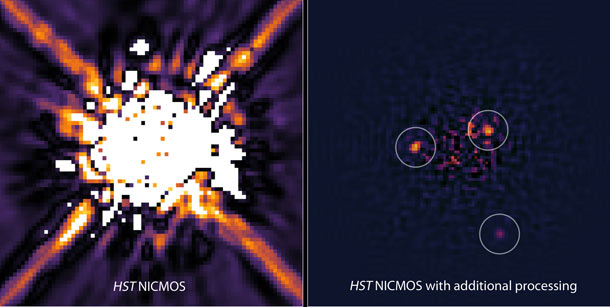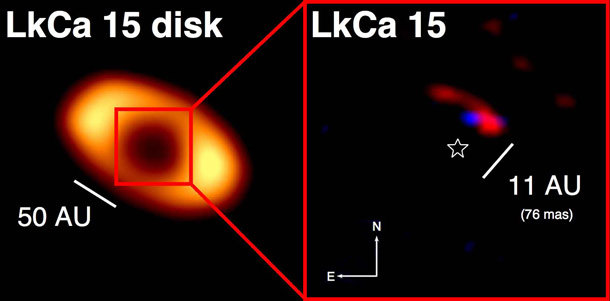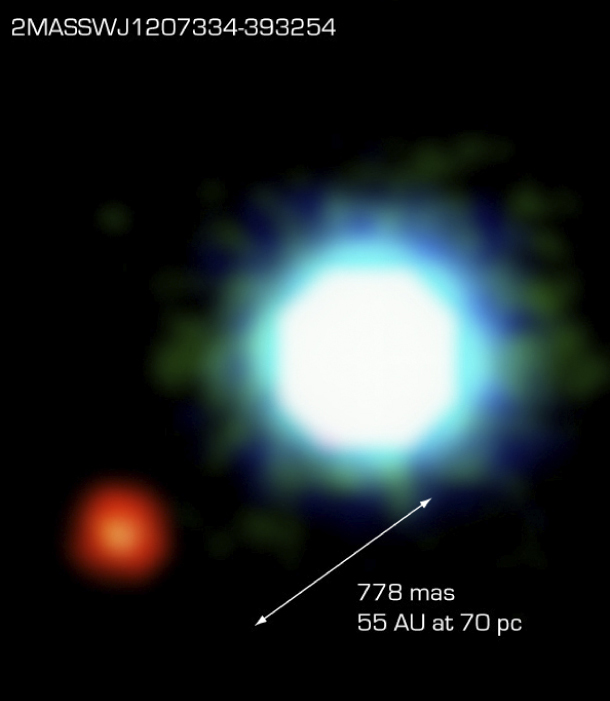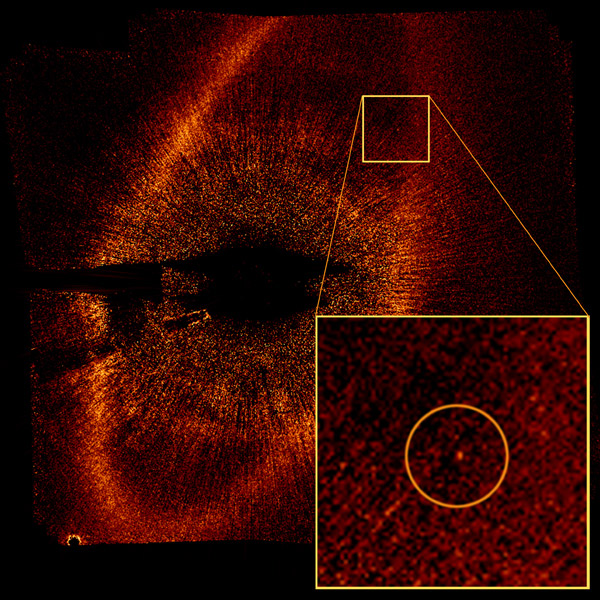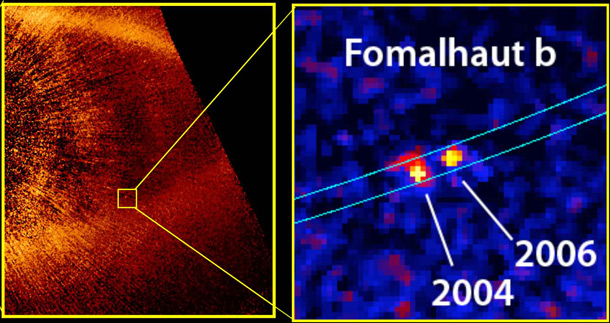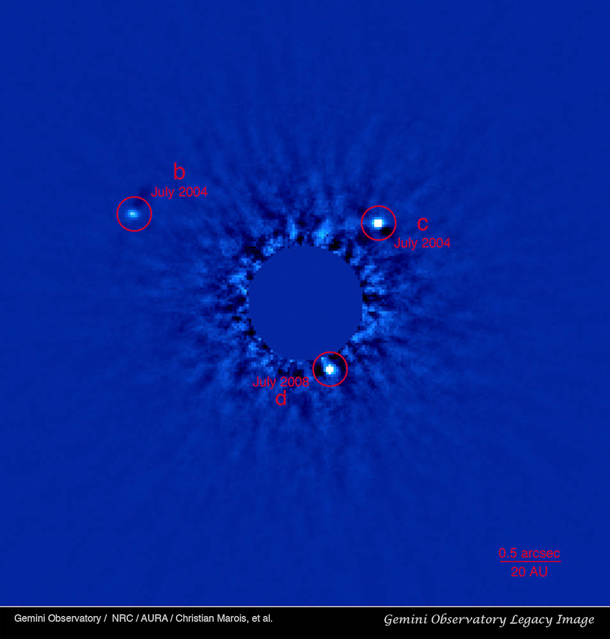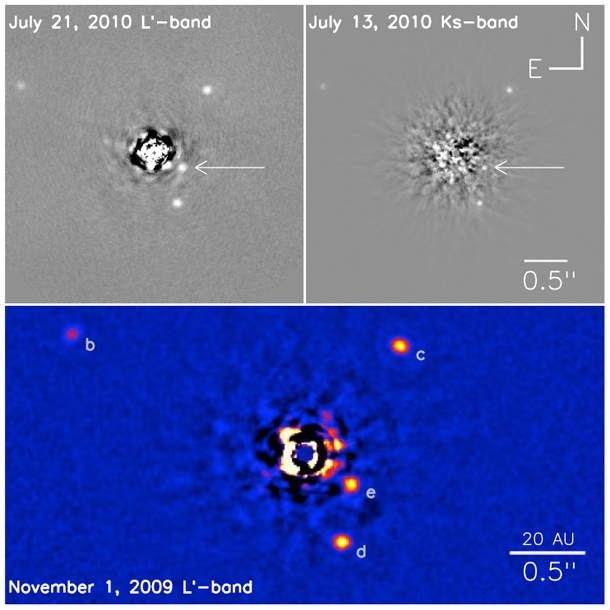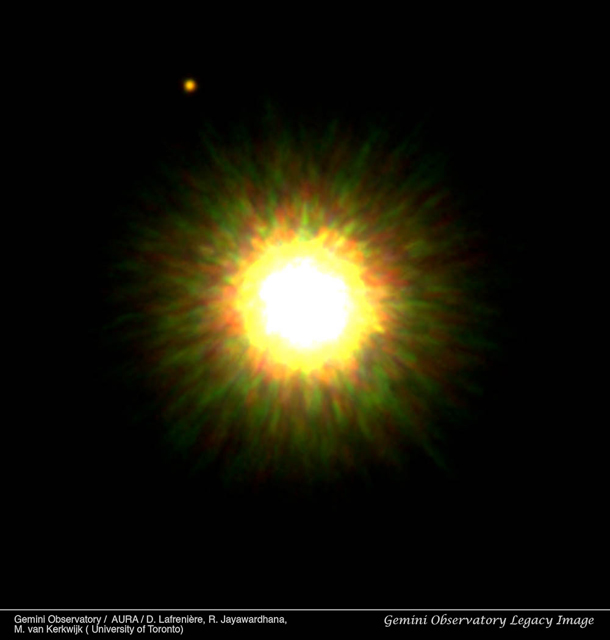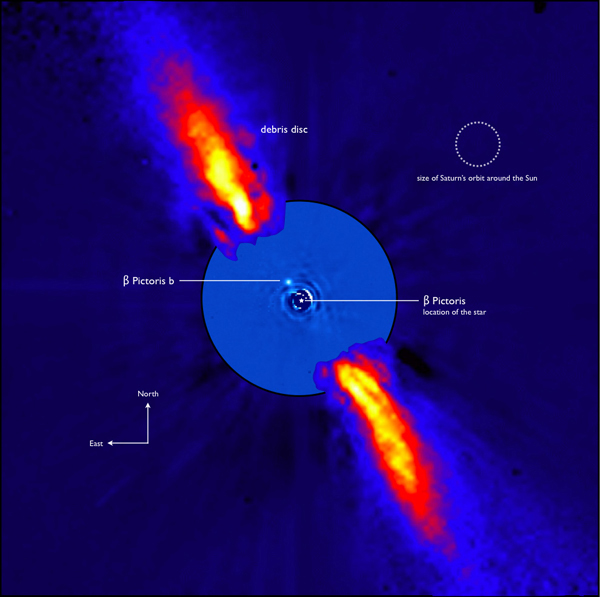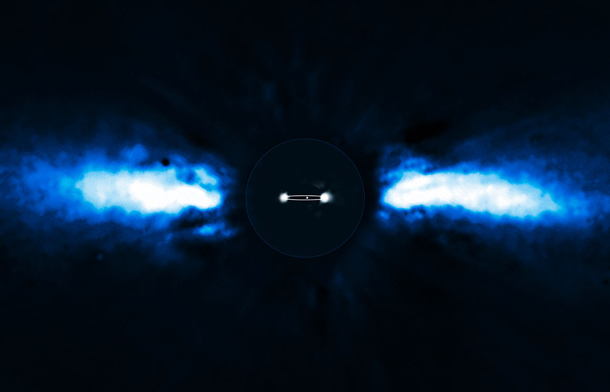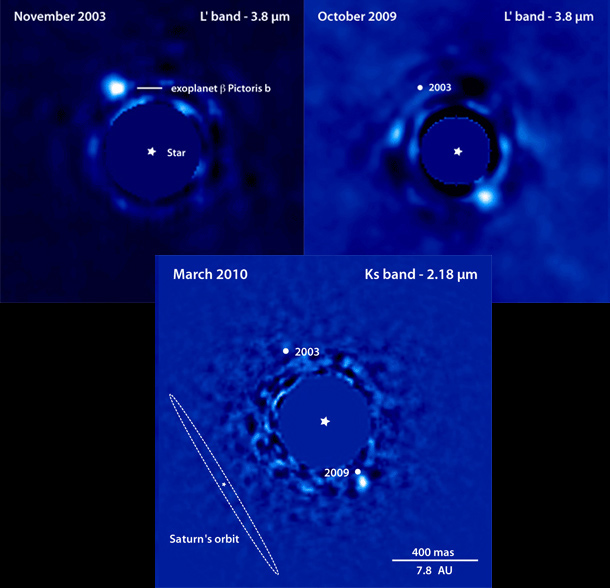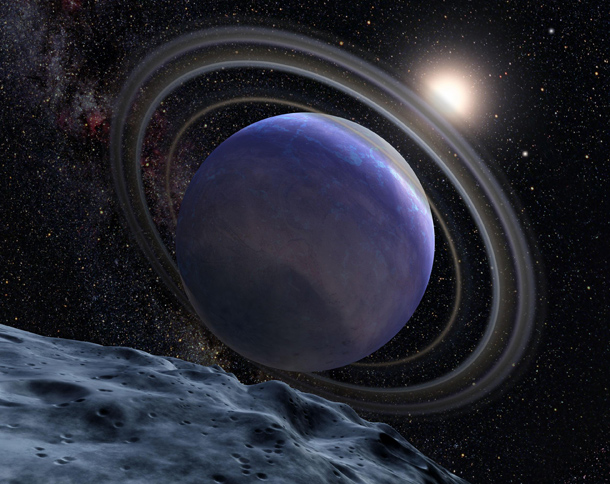Exoplanets seen by Hubble in 1998 finally revealed
In 1998, the Hubble Space Telescope was pointed at HR 8799, in hopes of seeing any potential planets that might be orbiting that nearby, Sun-like star. None were found... but in 2008 images using the Gemini telescope found several planets orbiting HR 8799. In fact, four planets were discovered there!
So why weren't they seen in the Hubble data? The star was too bright, and software techniques in 1998 couldn't sufficiently remove the star's light to reveal the much fainter planets. But things have changed in 13 years, and astronomers went back to the old HST data, using newly-developed methods to clean the images. And lo, they saw three of the four planets!
[Click to exoplanetate.]
On the left is the image of the star as seen by Hubble's infrared camera NICMOS. On the right, the star's light has been subtracted, and the three planets (HR 8799 c, d, and b, from left to right) can be clearly spotted.
 In a sense, this makes the Hubble image to be the very first image of exoplanets ever taken! But I think that's not entirely fair, since they weren't seen, nor really even able to be seen back then.
In a sense, this makes the Hubble image to be the very first image of exoplanets ever taken! But I think that's not entirely fair, since they weren't seen, nor really even able to be seen back then.
The very cool thing is that this older image gives us a much longer baseline over which we can see the planets. Why is that cool? Because the planets have moved over those 10 years between images! By comparing the old image and the one from 2008, the motion of the planets as they orbit the star can be directly seen and measured. Calculations based on that observation show the planets d, c, and b take about 100, 200, and 400 years to circle HR 8799 once, respectively. Given more time, we'd've figured that out anyway, but getting this image from Hubble is like getting an extra 10 years for free. So these planets join one around the star Beta Pic and another around Fomalhaut as being directly seen to move over time. Pretty amazing.
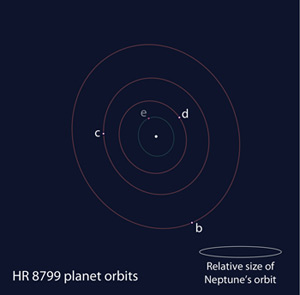 I'll note that the fourth planet, e, is too close to the star to be seen even using the new method. It sits just on the edge of a piece of metal called an occulting disk, which is used to block the majority of the light from the star, allowing fainter stuff to be seen. Even with the disk masking the star, the planets are incredibly faint and difficult to see.
I'll note that the fourth planet, e, is too close to the star to be seen even using the new method. It sits just on the edge of a piece of metal called an occulting disk, which is used to block the majority of the light from the star, allowing fainter stuff to be seen. Even with the disk masking the star, the planets are incredibly faint and difficult to see.
I worked on data very similar to this on Hubble around the same time this image was taken, and in fact wrote software to try to spot planets (as well as dust and other material) near their parent stars. It was incredibly finicky work, and obviously I wasn't able to see any planets then.
The new technique makes me a bit jealous. One thing it relies on is a database of images of 466 (!) stars observed in the same way as the target star. By adding them together digitally, a very accurate model of the target star can be made, and used to literally subtract the star's light. I tried this same method back in '98, but we didn't have the observations necessary for it. I used computer-generated star models, and they simply weren't accurate enough back then to do this kind of work.
But oh, how hard I worked on this project! To be the first to have actually seen a planet orbiting another star... but I probably would've had a coronary. Maybe it's all for the best.
Of course, that makes me wonder: how many more planets are lurking in images already taken, simply waiting to be dug up? We observed quite a few nearby stars, looking for exoplanets. I have a sneaky suspicion we may be seeing more of these kinds of images soon.
Image credit: NASA, ESA, and R. Soummer (STScI)
[Below is a gallery of exoplanets that have been directly imaged using telescopes on ground and in space. Click the thumbnail picture to get a bigger picture and more information, and scroll through the gallery using the left and right arrows.]
Related posts:
- HUGE EXOPLANET NEWS ITEMS: PICTURES!!!
- Another exoplanet joins the HR 8799 family
- Two exoplanets discovered by “citizen scientists”
- More images of exoplanet show it orbiting its star
Bad Astronomy Gallery
(click any image to see it full size)
We know of nearly 500 other planets orbiting other stars. However, the methods of finding these exoplanets are indirect. We measure their effect on their parent stars, but we didn't directly see the planets themselves... until 2005, when the first image of an actual world orbiting another star was announced.
As of October 2010, only 7 such planets have been imaged, but we'll soon have more. This gallery shows the best of these images, including the first alien solar system to have its picture taken.
The picture above is an artist's drawing of the planet Gliese 581c. Until recently, the only tool we had to see alien planets was our imagination. But that's changed... it'll be a long time before we get pictures as detailed as this, but in the meantime, we're still getting amazing images and learning a lot about these exotic worlds.
Click the image to go to the next one in the gallery, or use the nifty index slider at the top of the post.
Original Gliese 581 c blog post: Possible earthlike planet found in the Goldilocks zone of a nearby star!
Artwork credit: ESO
The planet is roughly six times the mass of Jupiter, and is glowing in the IR with the heat of its formation, still brewing at 500 - 1000 Kelvins. It orbits its star at distance of about 2.5 billion kilometers, inside the central gap in the larger disk, which is probably due to the planet having swept up material.
Original blog post: The first direct image of a baby planet being born! (maybe!)(but probably!)
Artwork credit: Kraus and Ireland
The star in question is a brown dwarf (what some people unfairly call a failed star) called 2MASSWJ1207334-3932 - or 2M1207 for short - located about 230 light years from Earth. This false-colored infrared image shows the star as blue, and the planet red.
The planet, called 2M1207 b, has about 5 times the mass of Jupiter, and orbits the star over 8 billion km (5 billion miles) out, about twice the distance of Neptune from the Sun.
The planet was first seen in 2004, but astronomers had to wait a year to confirm it really was a planet and not a background star or galaxy. Over time, as the star moved slightly in our sky, the planet moved with it, confirming they were a pair.
This picture is indeed historic, but left many people unsatisfied. Brown dwarfs are bigger than planets, but not really stars, either. And while 2M1207 b was definitely a planet, everybody was hoping to find a planet around a bona-fide star like the Sun.
They didn't have to wait long...
Original blog post: First exoplanet imaged!
Credit: ESO
When this picture of the nearby bright star Fomalhaut was released by Hubble, I had to laugh. We got a picture of Sauron's eye!
The star is actually not seen in this image; it's so bright the light from it was masked and subtracted away so that fainter objects could be seen. Amazingly, this bright ring of material popped right out of the picture; it's a vast circle of dust 36 billion km (21 billion miles) across.
Hidden in that picture is the exoplanet Fomalhaut b. It looked like just another pixel of noise in the first 2004 image, but was seen to move a little bit in an image taken in 2006. It took two more years to confirm it, but then the announcement was made in 2008: the second extrasolar planet had been directly seen!
It orbits Fomalhaut at a distance of 18 billion km (10.7 billion miles), but its mass is unknown, though estimated from to be about three times that of Jupiter (if it were any more massive, it would noticeably distort the ring). Amazingly, the star is about one billion times brighter than the planet, giving you an idea of how freaking hard these observations are.
Original blog post: HUGE EXOPLANET NEWS ITEMS: PICTURES!!!
Credit: NASA, ESA, P. Kalas, J. Graham, E. Chiang, E. Kite (University of California, Berkeley), M. Clampin (NASA Goddard Space Flight Center), M. Fitzgerald (Lawrence Livermore National Laboratory), and K. Stapelfeldt and J. Krist (NASA Jet Propulsion Laboratory)
The previous image shows the discovery of the planet Fomalhaut b, about 25 light years from Earth. This image shows better how they confirmed it was a planet: over the course of two years, the planet moved a tiny bit as it orbited its parent star. It takes over 870 years to circle the star once!
Credit: Paul Kalas, U C Berkeley
They found not one but three planets orbiting the star HR 8799, a slightly hotter and more massive star than the Sun, located about 130 light years away. The star is about 60 million years old. The brilliant light from the star has been masked out to show the much fainter planets.
The planets, labeled b, c, and d, are about 7, 10, and 10 times the mass of Jupiter, respectively, and orbit their star at 68, 38, and 24 times the distance of the Earth from the Sun.
HR 8799 b is clearly a planet, but the other two have masses uncertain enough that they might barely qualify as brown dwarfs. However, models of the system show that if the planets really are more massive, their mutual gravity would destabilize the system. It's likely then they are closer to the lighter end, making them planets as well.
This picture qualifies as another first as well: the first one taken from the ground of planets around a sun-like star. The first exoplanet was seen orbiting a brown dwarf, and the Fomalhaut pictures were taken from space, using Hubble. What this picture meant is that it was possible to take high-contrast, high-resolution images using ground-based observatories, which are far easier to manage and are far easier and cheaper to build than space observatories. It promised to usher in a new age of planetary detection.
Original blog post: HUGE EXOPLANET NEWS ITEMS: PICTURES!!!
Credit: Gemini Observatory
The planet has a mass of about 7 times that of Jupiter, though that's an estimate; it depends on the age! The planet is still glowing with the leftover heat of its formation, and the brightness depends on both its mass and its age. Since the age isn't exactly known, the mass can only be estimated.
Interestingly, the authors of the discovery paper note that current planet formation computer models can't make planets like this at the distance of HR 8799 e from its parent star. Either the models are wrong, or the planet formed farther out from the star and moved inwards; the latter is something that is fairly certain to happen when planets are young.
Either way, this new discovery adds excitement to the new field of exoplanet hunting, as well as those who are scratching their heads trying to figure out how these planets form.
Four planets were found orbiting the star HR 8799 in 2008. However, observations of the star taken in 1998 were found to have three of those planets in them, hidden by the glare of the star! Improved techniques in software and analysis revealed the planets, buried in the star's glare.
Original blo
g post: Exoplanets seen by Hubble in 1998 finally revealed
Image credit: NASA, ESA, and R. Soummer (STScI)
A spectrum is simply the mapping out of the colors of light, spreading out the light from an object into its component colors. Right away, you can see why doing this with faint objects is hard. You're taking the light that would normally be concentrated into a small circle a few pixels across and then spreading it out over a line that might be hundreds or thousands of pixels long! That takes a faint object and makes it hundreds of times fainter.
Worse, when you're taking an exoplanet's spectrum, it's also sitting very close to a star that might be millions of times brighter, which totally swamps the exoplanet signal. I spent quite a bit of time years ago doing this exact thing, and it nearly drove me nuts. Nearly.
But some other astronomers were more successful than me: they were able to tease out the spectrum of HR 8799 c in the infrared, obtaining a direct spectrum of an exoplanet for the first time. In fact, their data were good enough to show that models of how exoplanetary atmospheres absorb and reflect their star's light must be modified!
In this picture, the star HR 8799 is shown on the left, with the position of the planet circled. The picture on the right shows the blaring spectrum of the star, some reflections called "ghosts", and the extremely faint spectrum of the planet. It really shows you just how tough this observation was.
Credit: ESO/M. Janson
It was touted as the first direct image of an exoplanet orbiting a sun-like star, but that's not really the case. The system of planets around HR 8799 shown in the previous image was first observed in October 2007, and the confirmation came in July 2008. This planet, called 1RXS 1609 b, was seen in images taken in April 2008 but not announced until September.
In the exoplanet hunting game, weeks count! And the order of observations may not match the confirmation and announcements. Now imagine if planets are eventually detected in images taken earlier than any of these. How confusing would that be?
Either way, record or not, this is an interesting case. The large distance of the planet from its star - 50 billion km (30 billion miles) - is far more than any other planet discovered. It's a struggle to understand how such a planet could have formed that far out. Perhaps it formed closer in and got tossed out by another massive planet orbiting nearby. Perhaps it formed more like a brown dwarf, collapsing from the material from which the star itself formed (planets usually form from disks of material closer in, slowly gaining mass through collisions). That seems unlikely though; that process should make objects more massive than this planet (which has about 8 times the mass of Jupiter).
We're still new at this, and observations are scarse. As we get better, we'll learn more... and solve some of the pervasive mysteries about how planets form and how they age.
Original blog post: Another direct picture of a planet orbiting an alien star confirmed!
Credit: Gemini Observatory
In this infrared image - taken in 2003, by the way, making it the oldest image known to have an exoplanet in it - the star Beta Pictoris has its light masked out, revealing the planet Beta Pic b, as well as a ring of dust seen edge on (a bit like Saturn's rings). The disk was first discovered in the 1980s, and as imaging got better, the disk was seen to have several features making it look like something closer in to the star was disrupting it.
That "something" turned out to be the planet. Of all the directly imaged exoplanets, it's the closest to its star; it's about the same distance from Beta Pic as Saturn is from the Sun. The planet probably has a mass about 9 times that of Jupiter, and orbits the star once every 15 years or so.
Two more interesting points: Beta Pic is only about 12 million years old. This means planets form extremely quickly after their star does! Also, back in November 1981 the light from the star mysteriously dipped for about a day. It's been suggested that the planet passed directly between us and the star, blocking a bit of its light! If that's the case, then astronomers can use all kinds of techniques to nail down the size of the planet and its distance from the star.
Beta Pic will probably be the most heavily observed of all the planet-bearing stars we know. We have an excellent chance here to learn a whole lot about exoplanets, and all we have to do is catch it at the right time!
Original blog post: Another exoplanet imaged!
Credit: ESO
That may not seem terribly important, but it is. For one thing, it helps nail down the orbital size and period of the planet. Also, in 2008 the planet wasn't seen at all; it was most likely behind or too close to the star to be seen. Again, that helps determine the orbit of the planet.
As mentioned in the previous entry, it's possible that the planet will transit the star. If it does, then we'll know the orbit even better, allowing things like the mass of the star to be better determined, as well as other orbital characteristics of the planet.
Original blog post: Astronomers see exoplanet orbiting its parent star!
Credit: ESO
This technique, once set up correctly, is actually not terribly hard to adapt to other telescopes. This means that new planets may be found far more rapidly than before. Direct imaging, once the most difficult of planet-finding methods, may become the most prolific!
Original blog post: Get ready to see lots more exoplanet images soon
Credit: ESO
This new infrared observation, taken with the Very Large Telescope, also indicate the planet has a mass of 7 - 11 times that of Jupiter, and is in the temperature range of 1100 - 1700 degrees Celsius.
Original blog post: More images of exoplanet show it orbiting its star
Artwork credit: M. Bonnefoy et al., published in Astronomy & Astrophysics, 2011, vol. 528, L15
Direct imaging of exoplanets is perhaps the newest field in all of astronomy. Ten years ago it didn't exist, and was something of a dream. Now we have images of seven tiny dots, seven blips of light indicating the presence of mighty planets.
And with the advent of spectroscopy, we'll learn even more: how hot they are, and what they have in their atmospheres. Eventually, with new technology, new telescopes on space, we'll be able to split their light ever finer, and who knows? Maybe, one day not too long from now, we'll see the tell-tale sign of molecular oxygen... the only way we know of to have molecular oxygen in an atmosphere over long periods of time is through biological activity. If we ever see it... that, my friends, will be quite a day indeed.
I think that is ultimately our goal. We're looking for planets now, but what we're really looking for is life, or at least planets capable of supporting it. That day may be a long way off, but in my opinion it's a day that will, eventually, come.
Artwork of HR 8799 b credit: NASA, ESA, and G. Bacon (STScI). Larger versions available on the NASA Images website.


